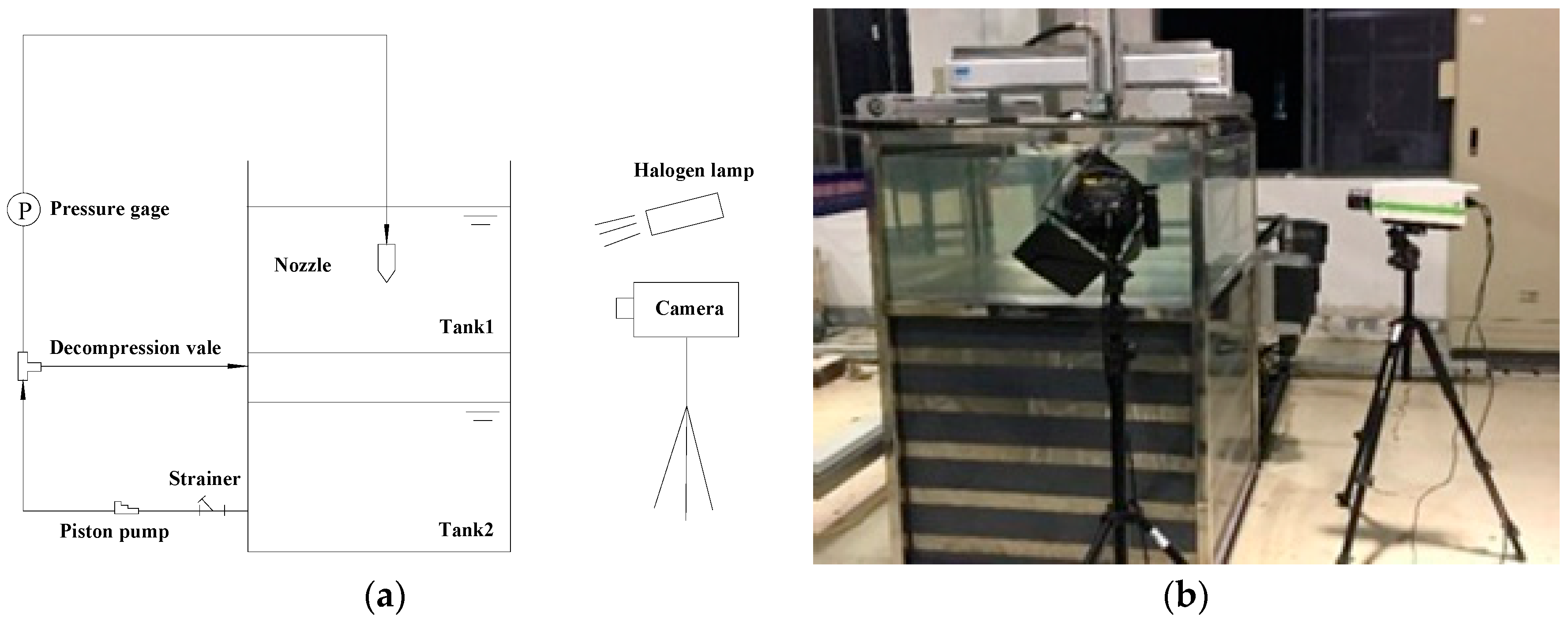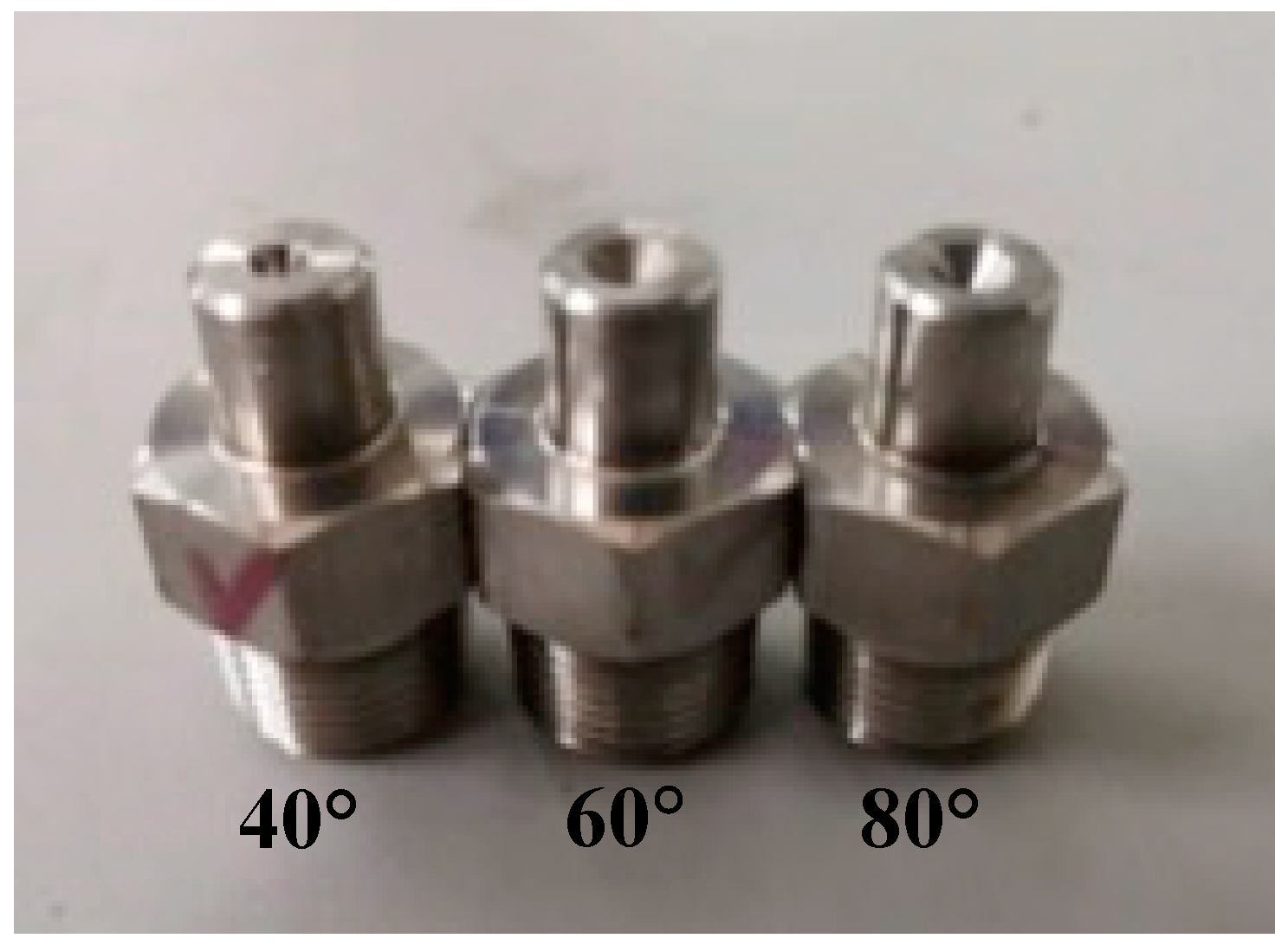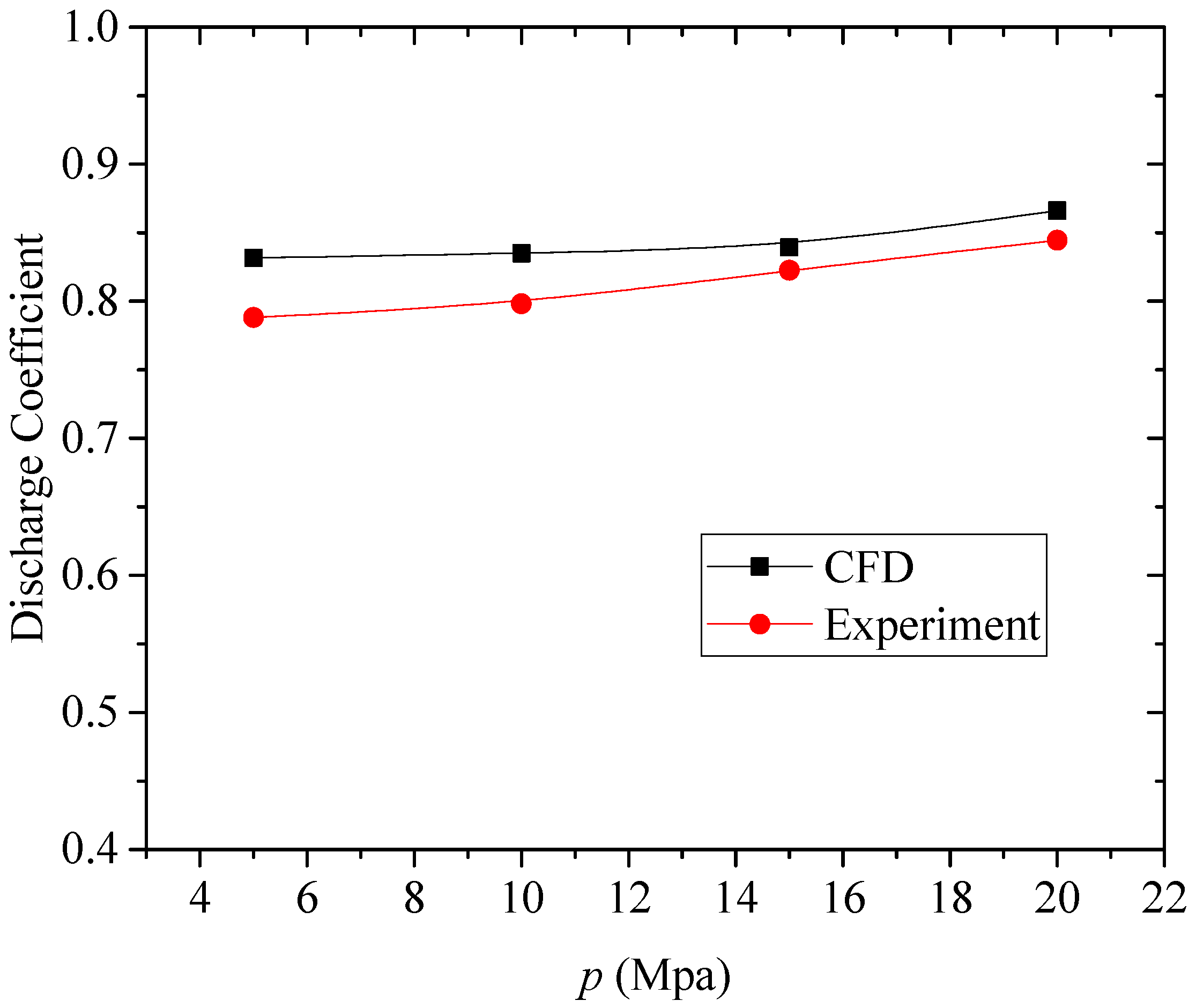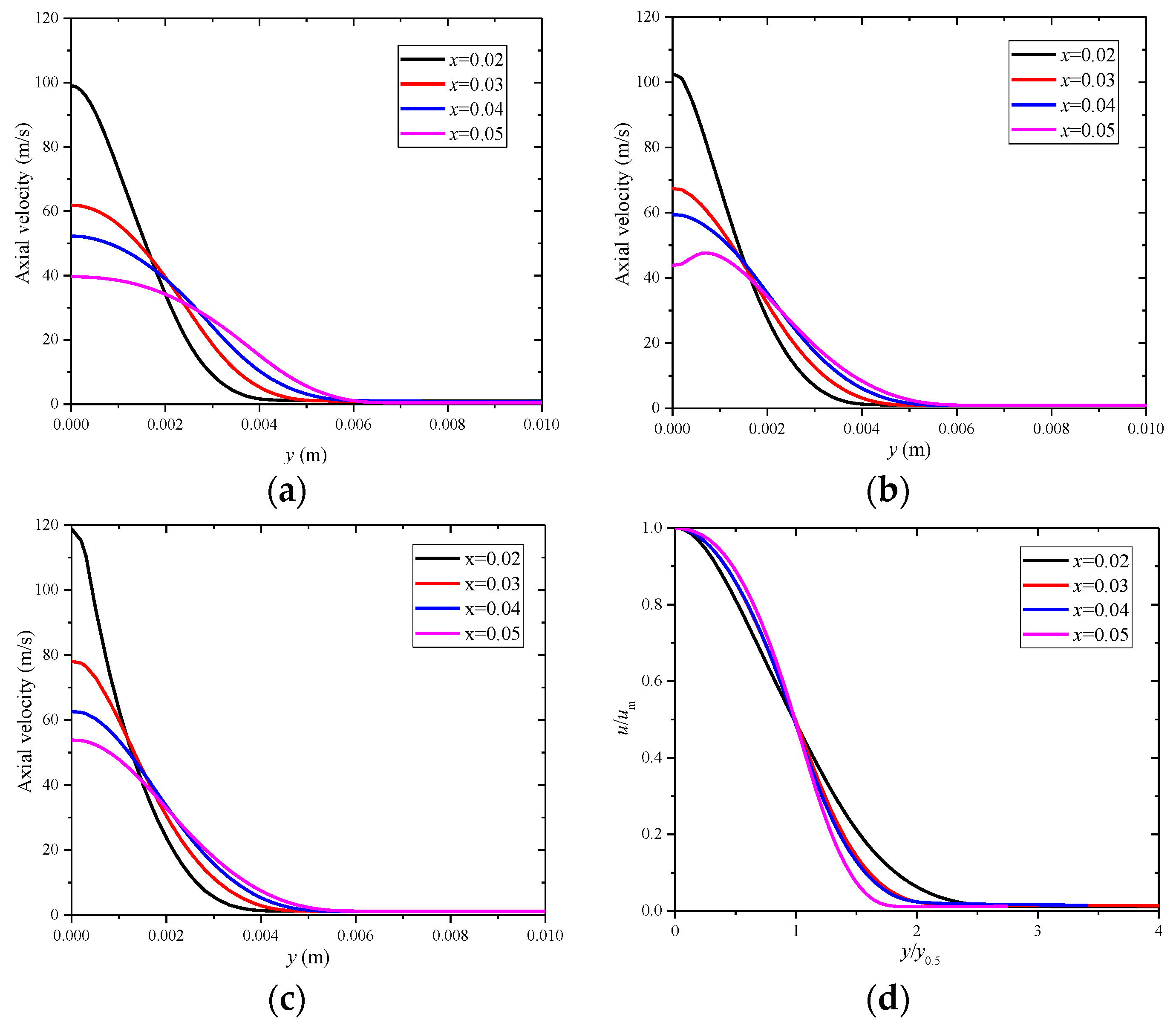Numerical Investigation of a High-Pressure Submerged Jet Using a Cavitation Model Considering Effects of Shear Stress
Abstract
:1. Introduction
2. Method for Experiment and Simulation
2.1. Experimental Method
2.2. Numerical Method
2.2.1. Multiphase Model
2.2.2. Turbulence Model
2.2.3. Cavitation Model
2.2.4. Geometry and Numerical Scheme
3. Results and Discussion
3.1. Validation of the Simulation Method
3.2. Influence of Geometric Parameters on Nozzle Performance
3.2.1. Nozzle Geometry Analysis Using Design of Experiments
3.2.2. Effect of Divergent Angle on the Nozzle Performance
4. Conclusions
- (1)
- The shear stress plays an important role in the simulation of the high-pressure cavitation jet. In the result of the ZGB cavitation model, the cavitation cloud of the submerged jet only appears close to the nozzle outlet and the length of it is quite different from the experimental result. When considering the shear stress in the model, the simulated result is matched with the experiment data, which contains the growing, shedding and collapsing parts of the jet. The period of the jet evolution predicted by the current cavitation model also agrees well with the high-speed photograph experimental result.
- (2)
- According to the orthogonal analysis, the main geometric parameter of the divergent-convergent nozzle that affects the jet performance is the nozzle diameter, and the divergent angle is the second most important factor. When the pressure is constant, the jet power increases with the increase of the nozzle diameter. Thus, the divergent angle of the nozzle plays the most important role in the cavitation impact of the jet, while the jet power is not changed.
- (3)
- The velocity field of the jet from different nozzles follows the similarity law, and the normalized distribution curves of the velocity are coincident for each case. The divergent angle of the nozzle affects the magnitude of the central velocity of the jet. The maximum velocity at the position 0.02m downstream of the nozzle outlet decreased by about 20m/s when the nozzle divergent angle was reduced from 80° to 40°.
- (4)
- According to the experimental test, the area of the metal eroded by the 40° nozzle is small and the surface roughness is still low, the 60° nozzle creates severe damage on the aluminum surface and deep pits appear on a large area of the impinged surface; the 80° nozzle shows a medium cavitation impact performance between the other two nozzles. The result using numerical simulation agrees well with the experimental erosion test, which concludes that the convergent-divergent nozzle has optimal cavitation performance when the divergent angle is close to 60°.
Author Contributions
Funding
Conflicts of Interest
References
- Wei, L.; Wang, C.; Shi, W.; Zhao, X.; Yang, Y.; Pei, B. Numerical calculation and optimization designs in engine cooling water pump. J. Mech. Sci. Technol. 2017, 31, 2319–2329. [Google Scholar] [CrossRef]
- Pawel, S.J. Assessment of Cavitation-Erosion Resistance of Potential Pump Impeller Materials for Mercury Service at the Spallation Neutron Source; ORNL/TM-2007/033; Oak Ridge National Laboratory: Oak Ridge, TN, USA, March 2007.
- Adamkowski, A.; Henke, A.; Lewandowski, M. Resonance of torsional vibrations of centrifugal pump shafts due to cavitation erosion of pump impellers. Eng. Fail. Anal. 2016, 70, 56–72. [Google Scholar] [CrossRef]
- Tan, L.; Zhu, B.; Cao, S.; Wang, Y.; Wang, B. Influence of Prewhirl Regulation by Inlet Guide Vanes on Cavitation Performance of a Centrifugal Pump. Energies 2014, 7, 1050–1065. [Google Scholar] [CrossRef]
- Wang, C.; Shi, W.; Wang, X.; Jiang, X.; Yang, Y.; Li, W.; Zhou, L. Optimal design of multistage centrifugal pump based on the combined energy loss model and computational fluid dynamics. Appl. Energy 2017, 187, 10–26. [Google Scholar] [CrossRef]
- Chang, H.; Li, W.; Shi, W.; Liu, J. Effect of blade profile with different thickness distribution on the pressure characteristics of novel self-priming pump. J. Braz. Soc. Mech. Sci. Eng. 2018, 40, 518. [Google Scholar] [CrossRef]
- Howard, S.C.; Graham, F.C.; Hochrein, A.A., Jr.; Thiruvengadam, A.P. Research and Development of a Cavitating Water Jet Cleaning System for Removing Marine Growth and Fouling from U. S. Navy Ship Hulls; No. DAI-SCH-7759-001-TR; Daedalean Associates Inc.: Woodbine, MD, USA, 1978.
- Arola, D.; Alade, A.E.; Weber, W. Improving Fatigue Strength of Metals Using Abrasive Waterjet Peening. Mach. Sci. Technol. 2006, 10, 197–218. [Google Scholar] [CrossRef]
- Fujisawa, N.; Fujita, Y.; Yanagisawa, K.; Fujisawa, K.; Yamagata, T. Simultaneous observation of cavitation collapse and shock wave formation in cavitating jet. Exp. Therm. Fluid Sci. 2018, 94, 159–167. [Google Scholar] [CrossRef]
- Soyama, H.; Kusaka, T.; Saka, M. Peening by the use of cavitation impacts for the improvement of fatigue strength. J. Mater. Sci. Lett. 2001, 20, 1263–1265. [Google Scholar] [CrossRef]
- Soyama, H.; Asahara, M. Improvement of the corrosion resistance of a carbon steel surface by a cavitating Jet. J. Mater. Sci. Lett. 2000, 19, 1201–1205. [Google Scholar] [CrossRef] [Green Version]
- Yamauchi, Y.; Soyama, H.; Adachi, Y.; Sato, K.; Shindo, T.; Oba, R.; Oshima, R.; Yamabe, M. Suitable Region of High-Speed Submerged Water Jets for Cutting and Peening. Int. J. Multiph. Flow 2008, 22, 31–38. [Google Scholar]
- Hutli, E.; Nedeljkovic, M.S.; Bonyár, A.; Légrády, D. Experimental Study on the Influence of Geometrical Parameters on the Cavitation Erosion Characteristics of High Speed Submerged Jets. Exp. Therm. Fluid Sci. 2017, 80, 281–292. [Google Scholar] [CrossRef]
- Hutli, E.; Nedeljkovic, M.; Bonyar, A. Cavitating flow characteristics, cavity potential and kinetic energy, void fraction and geometrical parameters—Analytical and theoretical study validated by experimental investigations. Int. J. Heat Mass Transf. 2018, 117, 873–886. [Google Scholar] [CrossRef]
- Hutli, E.; Nedeljkovic, M.S.; Bonyár, A.; Radovic, N.A.; Llic, V.; Debeljkovic, A. The ability of using the cavitation phenomenon as a tool to modify the surface characteristics in micro- and in nano-level. Tribol. Int. 2016, 101, 88–97. [Google Scholar] [CrossRef] [Green Version]
- Wang, C.; He, X.; Zhang, D.; Hu, B.; Shi, W. Numerical and experimental study of the self-priming process of a multistage self-priming centrifugal pump. Int. J. Energy Res. 2019, 43, 4074–4092. [Google Scholar] [CrossRef]
- Wang, C.; He, X.; Shi, W.; Wang, X.; Wang, X.; Qiu, N. Numerical study on pressure fluctuation of a multistage centrifugal pump based on whole flow field. AIP Adv. 2019, 9, 035118. [Google Scholar] [CrossRef] [Green Version]
- Guo, Q.; Zhou, L.; Wang, Z.; Liu, M.; Cheng, H. Numerical simulation for the tip leakage vortex cavitation. Ocean Eng. 2018, 151, 71–81. [Google Scholar] [CrossRef]
- Khatami, F.; Van Der Weide, E.; Hoeijmakers, H. Compressible Turbulent Flow Numerical Simulations of Tip Vortex Cavitation. J. Phys. Conf. Ser. 2015, 656, 012130. [Google Scholar] [CrossRef] [Green Version]
- Yin, B.; Yu, S.; Jia, H.; Yu, J. Numerical research of diesel spray and atomization coupled cavitation by Large Eddy Simulation (LES) under high injection pressure. Int. J. Heat Fluid Flow 2016, 59, 1–9. [Google Scholar] [CrossRef]
- Li, Z.R.; Zhang, G.M.; He, W.; van Terwisga, T. A numerical study of unsteady cavitation on a hydrofoil by LES and URANS method. J. Phys. Conf. Ser. 2015, 656, 012157. [Google Scholar] [CrossRef] [Green Version]
- Zhang, D.S.; Wang, H.Y.; Shi, W.D.; Zhang, G.J.; Van Esch, B.B. Numerical analysis of the unsteady behavior of cloud cavitation around a hydrofoil based on an improved filter-based model. J. Hydrodyn. Ser. B 2015, 27, 795–808. [Google Scholar] [CrossRef]
- Huang, B.; Wang, G.Y. Evaluation of a Filter-Based Model for Computations of Cavitating Flows. Chin. Phys. Lett. 2011, 28, 026401. [Google Scholar] [CrossRef]
- Wei, Y.J.; Tseng, C.C.; Wang, G.Y. Turbulence and cavitation models for time-dependent turbulent cavitating flows. Acta Mech. Sin. 2011, 27, 473–487. [Google Scholar] [CrossRef]
- Singhal, A.K.; Athavale, M.M.; Li, H.; Jiang, Y. Mathematical basis and validation of the Full Cavitation Model. J. Fluids Eng. 2002, 124, 617–624. [Google Scholar] [CrossRef]
- Sauer, J.; Schnerr, G.H. Unsteady cavitating flow—A new cavitation model based on modified front capturing method and bubble dynamics. In Proceedings of the ASME Fluids Engineering Division Summer Meeting, Boston, MA, USA, 11–15 June 2000. [Google Scholar]
- Zwart, P.J.; Gerber, A.G.; Belamri, T. A Two-Phase Flow Model for Predicting Cavitation Dynamics. In Proceedings of the Fifth International Conference on Multiphase Flow, Yokohama, Japan, 30 May–4 June 2004. [Google Scholar]
- Peng, G.; Shimizu, S.; Fujikawa, S. Numerical Simulation of Cavitating Water Jet by a Compressible Mixture Flow Method. J. Fluid Sci. Technol. 2011, 6, 499–509. [Google Scholar] [CrossRef] [Green Version]
- Suh, H.K.; Chang, S.L. Effect of cavitation in nozzle orifice on the diesel fuel atomization characteristics. Int. J. Heat Fluid Flow 2008, 29, 1001–1009. [Google Scholar] [CrossRef]
- Aleiferis, P.G.; Serras-Pereira, J.; Augoye, A.; Davies, T.J.; Cracknell, R.F.; Richardson, D. Effect of fuel temperature on in-nozzle cavitation and spray formation of liquid hydrocarbons and alcohols from a real-size optical injector for direct-injection spark-ignition engines. Int. J. Heat Mass Transf. 2010, 53, 4588–4606. [Google Scholar] [CrossRef] [Green Version]
- Sou, A.; Biçer, B.; Tomiyama, A. Numerical simulation of incipient cavitation flow in a nozzle of fuel injector. Comput. Fluids 2014, 103, 42–48. [Google Scholar] [CrossRef]
- Qi, L.; Guangyao, O.; Kun, Y.; Yupeng, S. Nozzle Inner Cavitation Flow Characteristics of Non-normal Fuel Based on High Pressure Injection Condition. Trans. Chin. Soc. Agric. Mach. 2016, 47, 333–339. [Google Scholar]
- Sun, T.Z.; Zong, Z.; Zou, L.; Wei, Y.J.; Jiang, Y.C. Numerical investigation of unsteady sheet/cloud cavitation over a hydrofoil in thermo-sensitive fluid. Hydrodyn. Res. Prog. 2017, 29, 987–999. [Google Scholar] [CrossRef]
- Yakhot, V.; Orszag, S.A. Renormalization group analysis of turbulence. I. Basic theory. J. Sci. Comput. 1986, 1, 3–51. [Google Scholar] [CrossRef]
- Johansen, S.T.; Wu, J.; Shyy, W. Filter-based unsteady RANS computations. Int. J. Heat Fluid Flow 2004, 25, 10–21. [Google Scholar] [CrossRef]
- Coutier-Delgosha, O.; Fortes-Patella, R.; Reboud, J.L. Evaluation of the Turbulence Model Influence on the Numerical Simulations of Unsteady Cavitation. In Proceedings of the 2001 ASME FEDSM, New Orleans, LA, USA, 29 May–3 June 2001. [Google Scholar]
- Huang, B.; Wang, G.Y.; Zhao, Y. Numerical simulation unsteady cloud cavitating flow with a filter-based density correction model. J. Hydrodyn. 2014, 26, 26–36. [Google Scholar] [CrossRef]
- Zhao, Y.; Wang, G.; Huang, B. A curvature correction turbulent model for computations of cloud cavitating flows. Eng. Comput. 2016, 33, 202–216. [Google Scholar] [CrossRef]
- Yu, A.; Ji, B.; Huang, R.; Zhang, Y.; Zhang, Y.; Luo, X. Cavitation shedding dynamics around a hydrofoil simulated using a filter-based density corrected model. Sci. China Technol. Sci. 2015, 58, 864–869. [Google Scholar] [CrossRef]
- Franc, J.P.; Michel, J.M. Fundamentals of Cavitation. Fluid Mech. Appl. 2004, 76, 1–46. [Google Scholar]
- Mcsherry, R.J.; Chua, K.V.; Stoesser, T. Large eddy simulation of free-surface flows. J. Hydrodyn. Ser. B. 2017, 29, 1–12. [Google Scholar] [CrossRef]
- Hutli, E.; Abouali, S.; Hucine, M.B.; Mansour, M.; Nedeljković, M.S.; Ilić, V. Influences of hydrodynamic conditions, nozzle geometry on appearance of high submerged cavitating jets. Therm. Sci. 2013, 17, 1139–1149. [Google Scholar] [CrossRef]
- Liu, H.; Kang, C.; Zhang, W.; Zhang, T. Flow structures and cavitation in submerged waterjet at high jet pressure. Exp. Therm. Fluid Sci. 2017, 88, 504–512. [Google Scholar] [CrossRef]
- Sato, K.; Takahashi, N.; Sugimoto, Y. Effects of Diffuser Length on Cloud Cavitation in an Axisymmetrical Convergent-Divergent Nozzle. In Proceedings of the ASME/JSME/KSME Joint Fluids Engineering Conference, Seoul, Korea, 26–31 July 2015. [Google Scholar]














| Number | A L2 (mm) | B d (mm) | C L3 (mm) | D β (°) |
|---|---|---|---|---|
| 1 | 2 | 0.5 | 2 | 40 |
| 2 | 4 | 1.0 | 4 | 60 |
| 3 | 6 | 1.5 | 6 | 80 |
| Number | A | B | C | D |
|---|---|---|---|---|
| 1 | 2 | 0.5 | 2 | 40 |
| 2 | 2 | 1.0 | 4 | 60 |
| 3 | 2 | 1.5 | 6 | 80 |
| 4 | 4 | 0.5 | 4 | 80 |
| 5 | 4 | 1.0 | 6 | 40 |
| 6 | 4 | 1.5 | 2 | 60 |
| 7 | 6 | 0.5 | 6 | 60 |
| 8 | 6 | 1.0 | 2 | 80 |
| 9 | 6 | 1.5 | 4 | 40 |
| Number | 1 | 2 | 3 | 4 | 5 | 6 | 7 | 8 | 9 |
|---|---|---|---|---|---|---|---|---|---|
| VOF | 0.039 | 0.049 | 0.091 | 0.023 | 0.069 | 0.199 | 0.019 | 0.064 | 0.179 |
| Number | A | B | C | D |
|---|---|---|---|---|
| K1 | 1.027146 | 0.264775 | 1.071998 | 1.169487 |
| K2 | 1.058102 | 1.089607 | 0.96127 | 0.953527 |
| K3 | 0.979006 | 1.709872 | 1.030986 | 0.94124 |
| k1 | 0.342382 | 0.088258 | 0.357333 | 0.389829 |
| k2 | 0.352701 | 0.363202 | 0.320423 | 0.317842 |
| k3 | 0.326335 | 0.569957 | 0.343662 | 0.313747 |
| R | 0.026365 | 0.481699 | 0.036909 | 0.076082 |
© 2019 by the authors. Licensee MDPI, Basel, Switzerland. This article is an open access article distributed under the terms and conditions of the Creative Commons Attribution (CC BY) license (http://creativecommons.org/licenses/by/4.0/).
Share and Cite
Yang, Y.; Li, W.; Shi, W.; Zhang, W.; A. El-Emam, M. Numerical Investigation of a High-Pressure Submerged Jet Using a Cavitation Model Considering Effects of Shear Stress. Processes 2019, 7, 541. https://doi.org/10.3390/pr7080541
Yang Y, Li W, Shi W, Zhang W, A. El-Emam M. Numerical Investigation of a High-Pressure Submerged Jet Using a Cavitation Model Considering Effects of Shear Stress. Processes. 2019; 7(8):541. https://doi.org/10.3390/pr7080541
Chicago/Turabian StyleYang, Yongfei, Wei Li, Weidong Shi, Wenquan Zhang, and Mahmoud A. El-Emam. 2019. "Numerical Investigation of a High-Pressure Submerged Jet Using a Cavitation Model Considering Effects of Shear Stress" Processes 7, no. 8: 541. https://doi.org/10.3390/pr7080541





